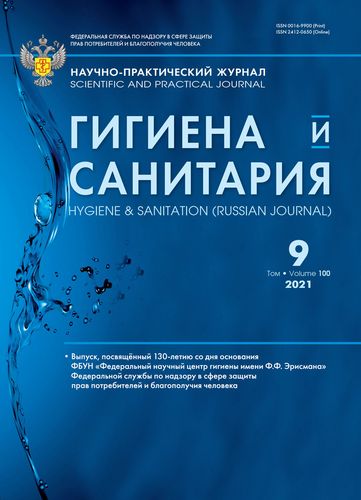Hygienic and chemical-analytical support for the safe use of pesticides of the dithiocarbamate group
- Authors: Larkina M.V.1, Mikheeva E.N.1, Fedorova S.G.1, Bondareva L.G.1
-
Affiliations:
- Federal Scientific Center of Hygiene named after F.F. Erisman of the Federal Service for Supervision in Protection of the Rights of Consumer and Man Wellbeing
- Issue: Vol 100, No 9 (2021)
- Pages: 1009-1012
- Section: METHODS OF HYGIENIC AND EXPERIMENTAL INVESTIGATIONS
- Published: 06.09.2021
- URL: https://rjraap.com/0016-9900/article/view/639023
- DOI: https://doi.org/10.47470/0016-9900-2021-100-9-1009-1012
- ID: 639023
Cite item
Full Text
Abstract
Introduction. There is continued trend in recent years of increasing the use of new chemicals, most of which are potential sources of risk to human health. The hygienic assessment of their application in the regions of the Russian Federation using various technologies is becoming more and more relevant.
The aim of the work was to determine the exposure levels of mankoceb, tiram and metiram (pesticides of the dithiacarbamate group), to establish the threshold of the acceptable risk of exposure to pesticides for workers while complying with technical recommendations and safety requirements.
Materials and methods. The determinations of the mancozeb, thiram and metiram were carried out by the gas-liquid chromatography with a flame-photometric detector (GC, FPD); the risk assessment was carried out by exposure (KBsumm) and absorbed dose (KBp) with a complex intake of active ingredients into the body of workers, under the Methodological Instructions № 1.2.3017-12.
Results. There were analyzed more than 350 samples of air of the working zone and washing from workers’ skin. There was shown an absence of active substances mancozeb and metiram in them. The insignificant content of thiram at a level close to the limit of its quantitative determination was found.
Conclusion. The results obtained allow assessing the risk of safe use of drugs based on dithiocarbamates in agriculture, which is the basis for predicting the total chemical exposure to humans, and accurately evaluating the levels of pollutants.
Contributions:
Larkina M.V. — collection and processing of the material, writing the text, editing, concept and design of the study;
Mikheeva E.N. — collection and processing of the material, writing the text, editing;
Fedorova S.G. — concept and design of the study;
Bondareva L.G. — writing the text, editing.
All authors are responsible for the integrity of all parts of the manuscript and approval of the manuscript final version.
Conflict of interest. The authors declare no conflict of interest.
Acknowledgement. The study had no sponsorship.
Keywords
About the authors
Maria V. Larkina
Federal Scientific Center of Hygiene named after F.F. Erisman of the Federal Service for Supervision in Protection of the Rights of Consumer and Man Wellbeing
Author for correspondence.
Email: analyt1@yandex.ru
ORCID iD: 0000-0002-8570-9769
MD, PhD, Senior researcher, Federal Scientific Center of Hygiene named after F.F. Erisman of the Federal Service for Supervision in Protection of the Rights of Consumer and Man Wellbeing, Mytishchi, 141014, Russian Federation.
e-mail: analyt1@yandex.ru
Russian FederationElena N. Mikheeva
Federal Scientific Center of Hygiene named after F.F. Erisman of the Federal Service for Supervision in Protection of the Rights of Consumer and Man Wellbeing
Email: noemail@neicon.ru
ORCID iD: 0000-0002-9633-5686
Russian Federation
Svetlana G. Fedorova
Federal Scientific Center of Hygiene named after F.F. Erisman of the Federal Service for Supervision in Protection of the Rights of Consumer and Man Wellbeing
Email: noemail@neicon.ru
ORCID iD: 0000-0001-8860-5298
Russian Federation
Lidiya G. Bondareva
Federal Scientific Center of Hygiene named after F.F. Erisman of the Federal Service for Supervision in Protection of the Rights of Consumer and Man Wellbeing
Email: noemail@neicon.ru
ORCID iD: 0000-0002-1482-6319
Russian Federation
References
- WHO. The WHO Recommended Classification of Pesticides by Hazard and Guidelines to Classification. Available at: https://www.who.int/ipcs/publications/pesticides_hazard_2009.pdf
- Greene S.A. Sittig’s Handbook of Pesticides and Agricultural Chemicals. USA SciTech Publishing, Inc.; 2006.
- Tomlin C. The Pesticide Manual, 14th ed. London: British Crop Protection Council (BCPC); 2006.
- Ware G.W., Whitacre D.M. Pesticide Book. Great Britain: Meister Publishing Co; 2004.
- Mandic-Rajcevic S., Rubino F.M., Ariano E., Cottica D., Neri S., Colosio C. Environmental and biological monitoring for the identification of main exposure determinants in vineyard mancozeb applicators. J. Expo. Sci. Environ. Epidemiol. 2018; 28(3): 289–96. https://doi.org/10.3390/toxics7030037
- Rakitskiy V.N., Yudina T.V., Fedorova N.E. Methodical problems of chemical-analytical safety assurance of products grown with the use of dithiocarbamates. Mezhdunarodnyy nauchno-issledovatel’skiy zhurnal. 2014; (4–4): 21–2. (in Russian)
- Safety and Health in Agricultural Field Operations. Department of Industrial Relations Division of Occupational Safety and Health Publications Unit. August 2020. Available at: https://www.dir.ca.gov/dosh/dosh_publications/Ag-Field-Operations.pdf
- Rein B.K. National Program Leader. Agri-Industry Systems/Farm Safety. Available at: https://nasdonline.org/1246/d001050/health-hazards-in-agriculture-an-emerging-issue.html
- Pesticides and Human Health Risk Assessment Policies, Processes, and Procedures. Available at: https://www.extension.purdue.edu/extmedia/ppp/ppp-48.pdf
- FAO. Worker exposure models and local risk assessment. Available at: https://www.fao.org/pesticide-registration-toolkit/registration-tools/assessment-methods/method-detail/ru/c/1187119/
- Thouvenin I., Bouneb F., Mercier T. Operator dermal exposure and protection provided by personal protective equipment and working coveralls during mixing/loading, application and sprayer cleaning in vineyards. Int. J. Occup. Saf. Ergon. 2017; 23(2): 229–39. https://doi.org/10.1080/10803548.2016.1195130
- Wong H.L., Garthwaite D.G., Ramwell C.T., Brown C.D. Assessment of exposure of professional agricultural operators to pesticides. Sci. Total Environ. 2018; 619: 874–82. https://doi.org/10.1016/j.scitotenv.2017.11.127
- Kim K.H., Kabir E., Jahan S.A. Exposure to pesticides and the associated human health effects. Sci. Total Environ. 2017; 575: 525–35. https://doi.org/10.1016/j.scitotenv.2016.09.009
- Marquart J., Brouwer D.H., Gijsbers J.H.J., Links I.H.M., Warren N., Van Hemmen J.J. Determinants of dermal exposure relevant for exposure modelling in regulatory risk assessment. Ann. Occup. Hyg. 2003; 47(8): 599–607. https://doi.org/10.1093/annhyg/meg096
- EFSA (European Food Safety Authority). Guidance on the assessment of exposure of operators, workers, residents and bystanders in risk assessment for plant protection products. EFSA J. 2014; (12): 3874.
Supplementary files









